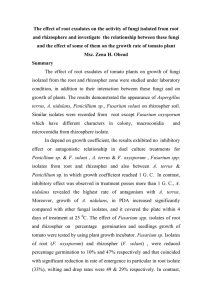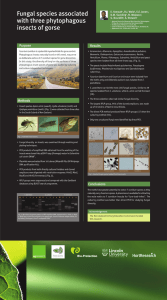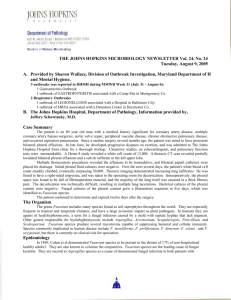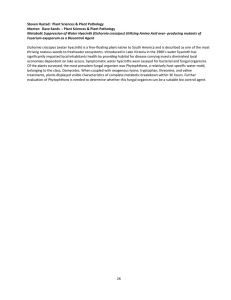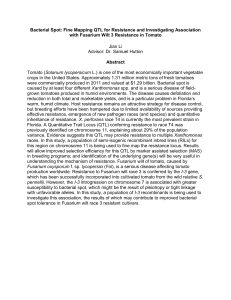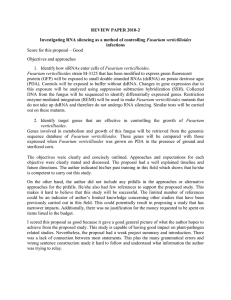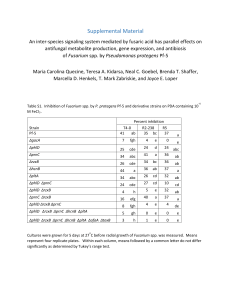Document 14246293
advertisement
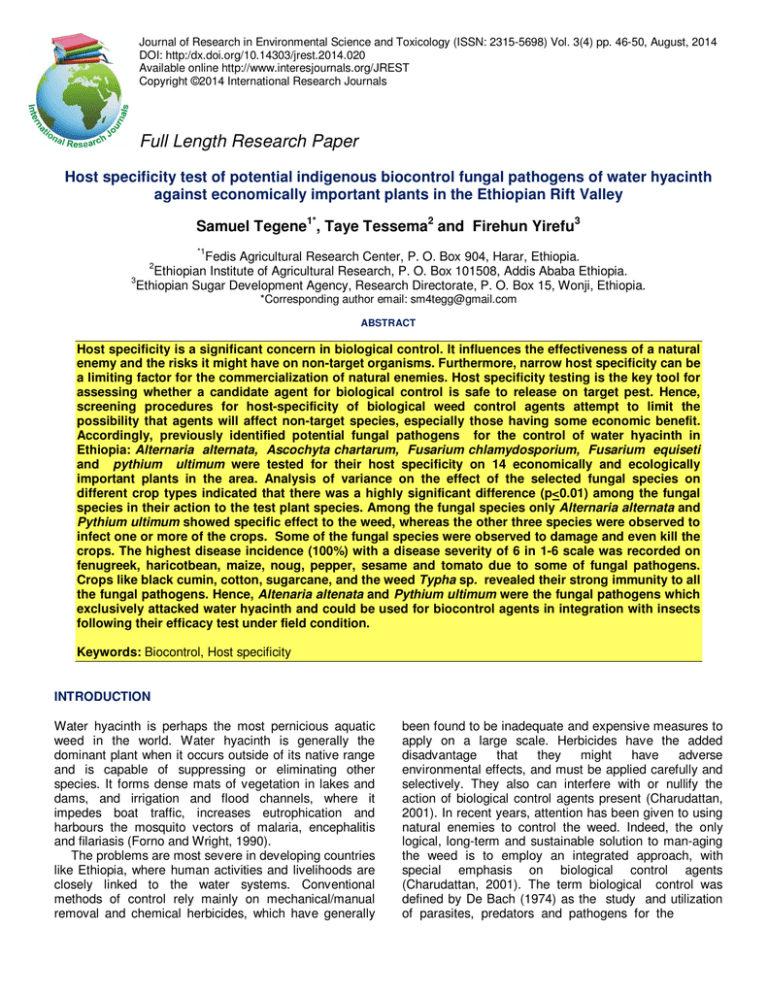
Journal of Research in Environmental Science and Toxicology (ISSN: 2315-5698) Vol. 3(4) pp. 46-50, August, 2014 DOI: http:/dx.doi.org/10.14303/jrest.2014.020 Available online http://www.interesjournals.org/JREST Copyright ©2014 International Research Journals Full Length Research Paper Host specificity test of potential indigenous biocontrol fungal pathogens of water hyacinth against economically important plants in the Ethiopian Rift Valley Samuel Tegene1*, Taye Tessema2 and Firehun Yirefu3 *1 Fedis Agricultural Research Center, P. O. Box 904, Harar, Ethiopia. Ethiopian Institute of Agricultural Research, P. O. Box 101508, Addis Ababa Ethiopia. 3 Ethiopian Sugar Development Agency, Research Directorate, P. O. Box 15, Wonji, Ethiopia. 2 *Corresponding author email: sm4tegg@gmail.com ABSTRACT Host specificity is a significant concern in biological control. It influences the effectiveness of a natural enemy and the risks it might have on non-target organisms. Furthermore, narrow host specificity can be a limiting factor for the commercialization of natural enemies. Host specificity testing is the key tool for assessing whether a candidate agent for biological control is safe to release on target pest. Hence, screening procedures for host-specificity of biological weed control agents attempt to limit the possibility that agents will affect non-target species, especially those having some economic benefit. Accordingly, previously identified potential fungal pathogens for the control of water hyacinth in Ethiopia: Alternaria alternata, Ascochyta chartarum, Fusarium chlamydosporium, Fusarium equiseti and pythium ultimum were tested for their host specificity on 14 economically and ecologically important plants in the area. Analysis of variance on the effect of the selected fungal species on different crop types indicated that there was a highly significant difference (p<0.01) among the fungal species in their action to the test plant species. Among the fungal species only Alternaria alternata and Pythium ultimum showed specific effect to the weed, whereas the other three species were observed to infect one or more of the crops. Some of the fungal species were observed to damage and even kill the crops. The highest disease incidence (100%) with a disease severity of 6 in 1-6 scale was recorded on fenugreek, haricotbean, maize, noug, pepper, sesame and tomato due to some of fungal pathogens. Crops like black cumin, cotton, sugarcane, and the weed Typha sp. revealed their strong immunity to all the fungal pathogens. Hence, Altenaria altenata and Pythium ultimum were the fungal pathogens which exclusively attacked water hyacinth and could be used for biocontrol agents in integration with insects following their efficacy test under field condition. Keywords: Biocontrol, Host specificity INTRODUCTION Water hyacinth is perhaps the most pernicious aquatic weed in the world. Water hyacinth is generally the dominant plant when it occurs outside of its native range and is capable of suppressing or eliminating other species. It forms dense mats of vegetation in lakes and dams, and irrigation and flood channels, where it impedes boat traffic, increases eutrophication and harbours the mosquito vectors of malaria, encephalitis and filariasis (Forno and Wright, 1990). The problems are most severe in developing countries like Ethiopia, where human activities and livelihoods are closely linked to the water systems. Conventional methods of control rely mainly on mechanical/manual removal and chemical herbicides, which have generally been found to be inadequate and expensive measures to apply on a large scale. Herbicides have the added disadvantage that they might have adverse environmental effects, and must be applied carefully and selectively. They also can interfere with or nullify the action of biological control agents present (Charudattan, 2001). In recent years, attention has been given to using natural enemies to control the weed. Indeed, the only logical, long-term and sustainable solution to man-aging the weed is to employ an integrated approach, with special emphasis on biological control agents (Charudattan, 2001). The term biological control was defined by De Bach (1974) as the study and utilization of parasites, predators and pathogens for the Tegene et al. 47 regulation of host population densities. These natural enemies of the target pest are referred to as control agents. They are usually host specific and obligate feeders. Biological control is the only control method that is economical, environmentally safe and sustainable. It is environmentally friendly and, unlike chemical control, it is perfectly safe where water is used for drinking. Host specificity is a significant concern in biological control. It influences the effectiveness of a natural enemy and the risks it might have on non-target organisms. Furthermore, narrow host specificity can be a limiting factor for the commercialization of natural enemies. Host specificity testing is the key tool for assessing whether a candidate agent for biological control is safe to release on target pest. Hence, screening procedures for hostspecificity of biological weed control agents attempt to limit the possibility that agents will affect non-target species, especially those having some economic benefit. Moreover the initial driver for testing weed biological control agents was to allay public fear of damage to economically useful plants (Harris, 1998). Typically, a variety of microorganisms, including common plant-associated saprophytes, plant parasites, and general members of the microbial community, reside on submerged plants such as hydrilla and water hyacinth. For instance, in one Florida study by Shabana and Charudattan (1995), 458 different microorganisms (211 bacteria, 202 fungi, 44 actinomycetes, and 1 cyanobacterium) were recovered from 48 samples taken from the ponds. Another 287 pathogens (132 bacteria, 154 fungal isolates, and 1 cyanobacterium) were recovered in 25 samples collected from the two lakes. Fungi belonging to several plant pathogenic genera, including Botryosporium, Cercosporidium, Chaetophoma, Diplodia, and Pyrenochaeta, were found mainly on hydrilla and in soil samples. The frequency and diversity of the microorganisms isolated confirmed the occurrence of a rich microbial flora associated with hydrilla (Shabana et al., 2000); this condition should be typical in any body of water infested with a submersed aquatic weed. In line with the above aforementioned facts, Tegene et al., 2012 identified that, Alternaria alternata, Ascochyta chartarum, Fusarium chlamydosporium, Fusarium equiseti and Pythium ultimum were an effective biocontrol agent against water hyacinth. In this study the authors recommended that performance evaluation of the identified pathogens under natural environmental conditions and the host specificity test was crucial for the pathogens to be utilized in controlling this weed. Besides, they further suggested the integration of these fungal agents with insect bio control for sustainable control of this weed. In line with this, this trial was accomplished to address the host specificity part of these pathogens so as to utilize pathogens in integrated manner with the neochetina weevils for the sustainable control water hyacinth. MATERIALS AND METHODS Fungal isolates which were identified as pathogenic to water hyacinth were prepared and inoculated using the method described by Tegene et al., 2012. Host specificity of isolates was done on different economically and ecologically important plant species, such as cereals (teff and maize); vegetables (pepper, cabbage and tomato); pulse (haricot bean); oil crops (sesame, noug); fiber crop (cotton); spices (fenugreek, cumin seeds); sugar crop (sugarcane); and typha spp. from weeds. Crop selection was made based on their importance and production coverage in lowland areas of the Rift Valley. Healthy seeds of each crop were collected from the respective research centers. Germination test of each crop was conducted before planting. Each crop was grown in a plastic bag filled with top soil from undisturbed land. Each soil filled plastic pot was perforated from all sides to allow proper infiltration and aeration. Based on their germination percentage and recommended seeding rate of each crop, definite number of each seed was sown in each plastic bag and allowed to grow outside the lath-house for fifteen days. Besides, the stage of each crop was synchronized to three-leaf stage by sowing each crop one after the other based on the germination dates of each crop. Watering, thinning and other management practices were done according to the recommendation for each crop. After three leaf stage establishment for each crop, the pots were brought to lath-house to acclimatize them with the lath-house condition for at least five days. Then the isolates which were pathogenic to water hyacinth were inoculated to the respective crops with the same procedure of Tegene et al., 2012. Pots with uninoculated plants of each species of crop were used as control. After inoculation, treatments were arranged in factorial RCBD with two replications. Seven days after inoculation isolates were rated for the incidence and severity of the isolates following the procedure stated under Tegene et al., 2012. Analyses of variances of incidence and severity were done using SAS computer software (SAS Institute, 1999). RESULTS AND DISCUSSION Analysis of effect of the selected fungal species on different crop types indicated that there was a highly significant difference (p<0.01) among the isolates in their action to the test crop species (Table 1). Among the fungal species only Alternaria alternata and Pythium ultimum showed specific effect to the weed only, whereas the other seven isolates infected one or more of the crops. Ascochyta chartarum was pathogenic to 48 J. Res. Environ. Sci. Toxicol. Figure 1. Severity of the disease caused by Fusarium chlamydosporum and Fusarium equseti on tomato and haricotbean Table 1. Disease intensity on inoculated important crop species at ESDARD Wonji lath-house Treatments Teff + Altenaria alternata Teff + Ascochyta chartarum Teff + Fusarium chlamydosporum Teff + Fusarium equiseti Teff + Pythium ultimum Teff with out isolates Maize + Altenaria alternata Maize + Ascochyta chartarum Maize + Fusarium chlamydosporum Maize+Fusarium equiseti Maize + Pythium ultimum Maize with out isolates Wheat + Altenaria alternata Wheat + Ascochyta chartarum Wheat + Fusarium chlamydosporum Wheat+Fusarium equiseti Wheat + Pythium ultimum Pepper + Altenaria alternata Pepper + Ascochyta chartarum Pepper +Fusarium chlamydosporum Pepper+Fusarium equiseti Pepper + Pythium ultimum Pepper with out isolates Tomato + Altenaria alternata Tomato + Ascochyta chartarum Tomato +Fusarium chlamydosporum Tomato +Fusarium equiseti Tomato + Pythium ultimum Tomato with out isolates Onion + Altenaria alternata Onion + Ascochyta chartarum Onion + Fusarium chlamydosporum Disease incidence (%) 0 0 0 0 0 0 0 0 100 100 0 0 0 0 0 0 0 0 100 0 100 0 0 0 100 0 97.5 0 0 0 0 0 Disease severity ( 1-6 scale)+ 1 1 1 1 1 1 1 1 6 6 1 1 1 1 1 1 1 1 6 1 4 1 1 1 6 1 6 1 1 1 1 1 Tegene et al. 49 Table 1. (Continiued…) Treatments Onion+ Fusarium equiseti Onion + Pythium ultimum Onion with out isolates Cabbage + Altenaria alternata Cabbage + Ascochyta chartarum Cabbage + Fusarium chlamydosporum Cabbage + Fusarium equiseti Cabbage + Pythium ultimum Cabbage with out isolates Haricotbean + Altenaria alternata Haricotbean + Ascochyta chartarum Haricotbean +Fusarium chlamydosporum Haricotbean + Fusarium equiseti Haricotbean + Pythium ultimum Haricotbean with out isolates Black cummin + Altenaria alternata Black cummin + Ascochyta chartarum Black cummin + F.chlamydosporum Black cummin + Fusarium equiseti Black cummin + Pythium ultimum Black cummin with out isolates Fenugreek + Altenaria alternata Fenugreek + Ascochyta chartarum Fenugreek + Fusarium chlamydosporum Fenugreek +Fusarium equiseti Fenugreek + Pythium ultimum Fenugreek with out isolates Noug + Altenaria alternata Noug + Ascochyta chartarum Noug + Fusarium chlamydosporum Noug + Fusarium equiseti Noug + Pythium ultimum Noug with out isolates Sesame + Altenaria alternata Sesame + Ascochyta chartarum Disease incidence (%) 0 0 0 0 0 76.5 100 0 0 0 87.5 54.02 48.17 0 0 0 0 0 0 0 0 28.5 100 0 0 0 0 58.45 83.5 75 0 0 0 100 Disease severity + ( 1-6 scale) 1 1 1 1 1 5 6 1 1 1 5 5 6 1 1 1 1 1 1 1 1 5 6 1 1 1 1 5 6 6 1 1 1 6 Table 1. (Continiued…) Treatments Sesame + Fusarium chlamydosporum Sesame + Fusarium equiseti Sesame + Pythium ultimum Sesame with out isolates Sugarcane + Altenaria alternata Sugarcane + Ascochyta chartarum Sugarcane + Fusarium chlamydosporum Sugarcane + Fusarium equiseti Sugarcane + Pythium ultimum Sugarcane with out isolates Cotton + Altenaria alternata Cotton + Ascochyta chartarum Cotton +Fusarium chlamydosporum Cotton + Fusarium equiseti Cotton + Pythium ultimum Cotton with out isolates Typha sp. + Altenaria alternata Disease incidence (%) 100 100 0 0 0 0 0 0 0 0 0 0 0 0 0 0 0 Disease severity (1-6 scale)+ 6 6 1 1 1 1 1 1 1 1 1 1 1 1 1 1 1 50 J. Res. Environ. Sci. Toxicol. Table 1. (Continiued…) Treatments Typha sp. + Ascochyta chartarum Typha sp. + Fusarium chlamydosporum Typha sp. + Fusarium equiseti Typha sp. + Pythium ultimum Typha sp. with out isolates SE p<0.01 CV(%) Disease incidence (%) 0 0 0 0 0 4.07 ** 11.10 Disease severity (1-6 scale)+ 1 1 1 1 1 + Disease severity rating scale: in 1-6 scale with 1 no infection and 6 very severe infection up to death ** Highly significant variation (p<0.01) was observed among isolates in their ability to infect crops fenugreek, noug, pepper, sesame and tomato. On the other hand, Fusarium chlamydosporum and Fusarium equseti showed a negative effect on crops like cabbage, fenugreek, haricot bean, maize, noug and sesame. In addition, Fusarium equiseti was also pathogenic to pepper and tomato (Table 1). Some of the isolates damaged and even killed the crops. The highest disease incidence (100%) with a disease severity of 6 in 1-6 scale was recorded on fenugreek, haricotbean, maize, noug, pepper, sesame and tomato due to Fusarium chlamydosporum and Fusarium equseti (Figure 1. and Table 1). Crops like black cumin, cotton, sugarcane, and the weed Typha sp. showed immune reaction to all the fungal pathogens. In general, the results showed that some of the important crops in the study area were not immune to all the putative fungal pathogens included in this host specificity test except for Alternaria alternata and Pythium ultimum. Hence all the 14 crop species including the weed Typha sp. were immune to these fungal pathogens. Therefore, Altenaria altenata and Pythium ultimum were the fungal pathogens which exclusively attacked water hyacinth. The results agree with the findings of Abbas et al. (1995), in which monocotyledonous crops, such as maize, wheat, as well as the dicot tomato, are tolerant to AAL-toxin, a product of Alternaria alternata. This study is consistent with other host specicifity test of Rhomela et al. (1999), in which banana, common bean, lettuce, mung bean, rice, soybean, string bean and winged bean showed highly resistant reactions to Alternaria alternata. Moreover, cabbage, okra and radish showed highly resistant to moderately resistant reactions respectively, while cotton showed moderately resistant to moderately susceptible reactions. CONCLUSION AND RECOMMENDATION The five potential fungal pathogens identified as biocontrol agents against water hyacinth revealed different reaction on the tested plants. Hence, some of the tested plants were highly susceptible to the fungal pathogens. However, all the tested plants were immuned to Altenaria altenata and Pythium ultimum. Therefore, these two fungal pathogens; which exclusively attacked water hyacinth, could be used for biocontrol agents in integration with insects following their efficacy test under field condition. REFERENCES Abbas HK, Duke SO, Paul RN, Riley RT, Tanaka T (1995). AAL-toxin, a potent natural herbicide which disrupts sphingolipid metabolism of plants. Pesticide Sci. 43(3): 181-187. Charudattan R (2001). Control of water hyacinth by the use of plant pathogens: 102: 23-25. In the M.H. Julien, M.P. Hill, T.D. Center and Jianqing, D. Proceedings of the Second Meeting of the Global Working Group for the Biological and Integrated Control of Water Hyacinth, Beijing, China. 9–12 October 2000. De-Bach P (1974). Biological Control of Pests and Weeds. Cambridge University Press. Forno IW, Wright AD (1990). Application for the release of Neochetina bruchi Hustache for biological control of the weed Eichhornia crassipes (Mart.) Solms. CSIRO Harris P (1998). Evolution of classical weed biocontrol: Meeting survival challenges. Bulletin of the Ecol. Society of Canada. 30: 134-143. Rhomela F, Masangkay M, Mabbayad O, Timothy CP, Alan KW (1999). Host range of Alternaria alternata causing leaf blight of Sphenoclea zeylanica, Cananadian J. Botany. 77(1): 103–112. SAS Institute (1999). SAS/Stat User’s Guide, Version 8. Cary, N.C: SAS Institute. Pp. 1-20. Shabana YM, Charudattan R (1997). Preparation and regeneration of mycelial protoplasts of Alternaria eichhorniae. J. Phytopathol. 145: 335–338. Shabana YM, Elwakil MA, Charudattan R (2000). Effect of media, light and pH on growth and spore production by Alternaria eichhorniae, a mycoherbicide agent for waterhyacinth. Zeitschrift für Pflanzenkrankhreiten und Pflanzenschutz – J. Plant Disease and Protection. 107: 617–626. Tegene S, Temam H, Taye T, Firehun Y, Butner C, Monika G (2012) Exploration of fungal pathogens associated with water hyacinth (Eichhornia crassipes (Mart.) Solms-Laubach) in Ethiopia. African J. Agric. Res. 7(1): 11-18. 5 January, 2012. Available online at http://www.academicjournals.org/AJAR DOI: 10.5897/AJAR11.222 ISSN 1991-637X ©2012 Academic J. unpublished report. Pp. 22.
